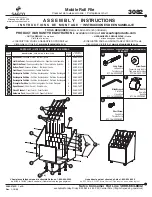
9.3 Index addressing of modules (slot, source) and units (channel)
When executing commands, it is almost always necessary to provide the index of a specific module or an index of a specific installed unit.
For the commands that require index values:
Index
Description
Value
<c>
the chassis index in which the specific blade module is installed
integer inclusive of
0
<n>
the slot (or source) index of the specific blade module
integer <
1
to
18
>
<m>
the channel index of a specific unit in the module
integer <
1
to
6
>
9.4 Message queues
Information is exchanged in the form of messages. These messages are held in input and output queues.
The output queue stores responses to query commands. The CohesionSCPI service transmits any data in the output queue when a read request is
received. Unless specified, all output response data is transmitted in ASCII format.
9.4.1 Status and event registers
9.4.1.1 Standard Event Status Register
The Standard Event Status Register (SESR) is modified by the Quantifi Photonics product with the results of the command operations.
Bit
Description
7 (MSB), 6
Not used
5
Is set when a Command Error event has been detected
4
Is set when a command Execution Error has been detected
3
Is set when a Device Dependent Error event has been detected
2
Is set when there a Query Error event has been detected
1
Not used
0 (LSB)
Is set when an Operation Complete event has been generated
9.4.1.2 Standard Event Status Enable Register (Mask)
The Standard Event Status Enable Register (SESR Mask) is used to build the Event Status Bit (ESB) within the Status Byte Register (STB). To ignore any
of the events detected and set in the SESR, set the corresponding bit within the SESR Mask to 0. The STB can then be queried and the value of the ESB
can be used to determine service request requirements based on the SESR Mask applied.
Quantifi Photonics | SLED 1000 / 1300 Series PXIe User Manual | Document version 1.08
36 / 61
















































